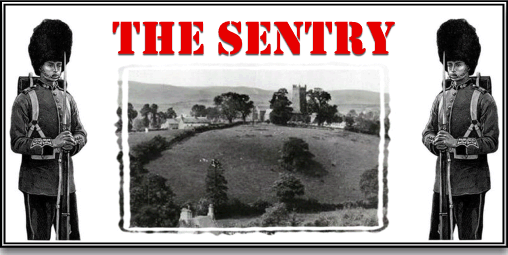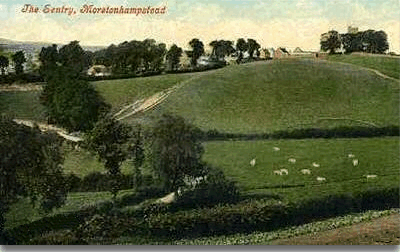
No this is not about a brave soldier who whilst on guard duty fought off single-handed a hoard of invaders, although it is the story of a battle. The Sentry is in fact a field by the church, originally it was called the Sanctuary Field, time and Devonshire dialect have since produced ‘Sentry’. In his book of field names, Field, 1989, p.196, confirms that there is a similar name at Widecombe-in-the-Moor and that the name ‘Sentry’ refers to ‘Sanctuary Field‘ ,meaning one that adjoins a churchyard. The Moretonhampstead Sanctuary Field was at one time a glebe field which meant it belonged to the church and was one that all incomes made from it went to the local rector.
George Friend, 1994, pp. 14-15, tales the story of how for centuries the Sentry had been used by the folk of Moretonhampstead as a recreational field and a merry time was had by all. That is until 1837 when the then rector one William Courtenay Clack decided there was profit to be had from the field. Accordingly he pointed out to the villagers that in effect the field was church property and even more important under his jurisdiction. In that light the rector announced that he intended to take a crop of hay off the field and that the children who played there were no longer welcome.
It did not take long for the village to rally together and in no time an ‘action committee was formed. Amongst their ranks were three esteemed solicitors and one farmer all who took on the fight for their traditional rights to use the field. Then just as things were hotting up William Courtenay Clack poured more ‘oil’ onto the burning flames by blocking up some of the footpaths that traversed across ‘The Sentry’. The result of this action soon came to fruition on the following Sunday. The first thing he noticed was that the church bells were not summoning the faithful in their normal way, they were in fact silent. This was because the bell ringers had boycotted the belfry, not only were the men bell ringers but many of them also belonged to the local cricket team who were now without a pitch to play on. Just before the service began the rector noticed that the choir stalls were devoid of ‘singests’ and the pews were woefully empty as well. It appears that nearly the whole of Moretonhampstead had voted with their feet and deserted the church.

An old postcard showing the Sentry Field.
After about a month it was deemed that the situation should be resolved and so the Earl of Devon, who was a patron of the church, summoned all the parties to attend a meeting at the White Hart Inn. The outcome of the meeting was that the people of Moretonhampstead had the recreational use of the field re-instated and as a bonus the Earl offered to install some seats at his own expense. It did not take long for the town to return to normal, on Sunday mornings the moorland air was filled with the peal of bells and Sunday afternoons it was alive with the sound of leather against willow.
There is a saying that, “history repeats itself”, and this story is no exception as in 1907, Stanley Dawes Dewey, the latest rector erected a barbed wire fence around the field because, in his opinion, he should not have to provide his parishioners with a recreational field to the detriment of his own pocket. This there was an official Parish Council to take on the battle and they soon took the matter to the Newton Abbot Rural District Council. It was requested that the council took action under the Barbed Wire Act of 1893 which basically made it illegal to obstruct a right of way with barbed wire.
Bibliography.
Field, J 1989 English Field Names, Sutton Publishing, Gloucester.
Friend, G. 1994 Memories of Moretonhampstead, Devon Books, Tiverton.
 Legendary Dartmoor The many aspects past and present of Dartmoor
Legendary Dartmoor The many aspects past and present of Dartmoor
